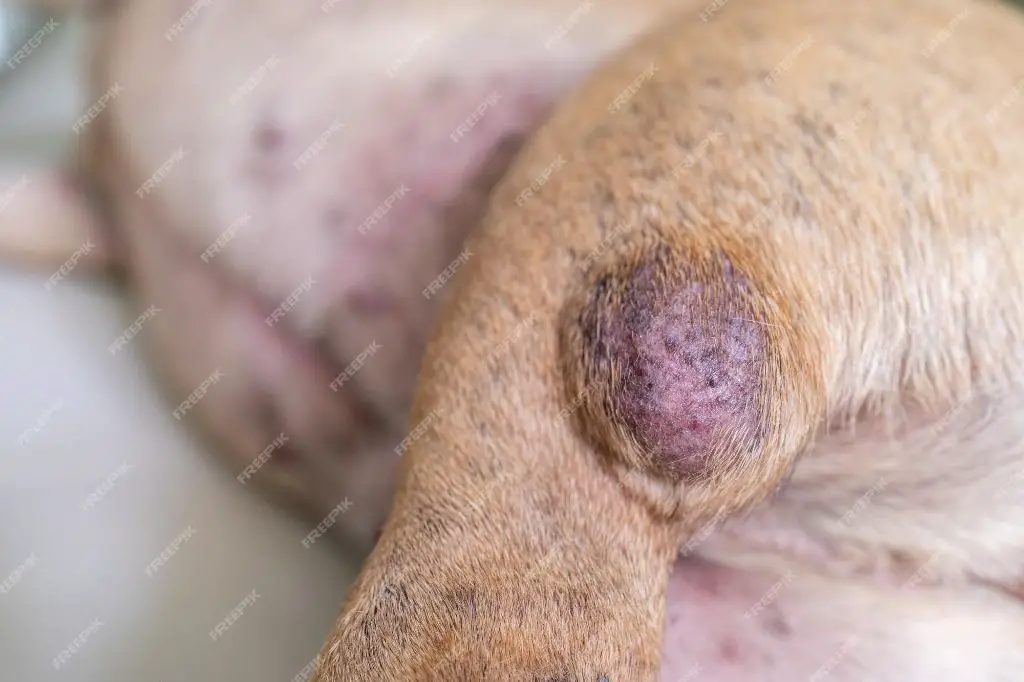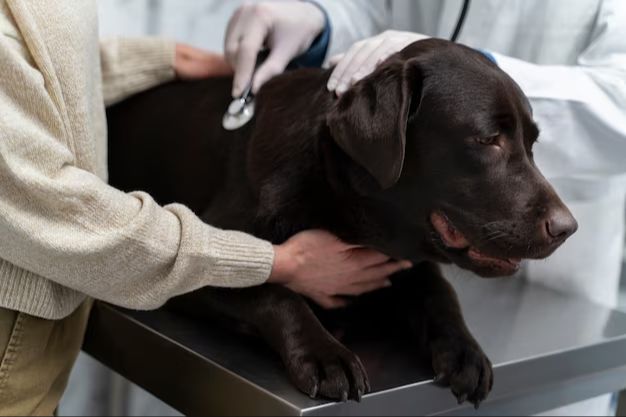Introduction

Cancer is a leading cause of illness and death in dogs. According to the Veterinary Medical Database, cancer accounts for nearly 50% of deaths each year in dogs over 10 years old. Understanding the mortality rate from various cancers in dogs is important for veterinarians to diagnose and treat cancer appropriately. It also helps dog owners make informed decisions about their pet’s health and wellbeing.
In this article, we will examine the percentage of dog deaths attributed to cancer. We will look at differences based on breed, age, and type of cancer. We will also discuss diagnosis, treatment options, quality of life concerns, and preventative measures for canine cancers.
Cancer as a Leading Cause of Death
Cancer is one of the leading causes of death in dogs. After reaching old age, cancer becomes the number one killer of our canine companions. Though dogs can get cancer at any age, the risk tends to increase as dogs get older. Cancer ultimately results when cells grow out of control and form abnormal masses or tumors. Some cancers may spread to other areas of the body in a process known as metastasis. While cancer was once a death sentence for most dogs, advancements in veterinary medicine now offer more treatment options and hope.
Percentage Breakdown of Cancer Deaths
Of all dogs that die from natural causes annually, it’s estimated that cancer accounts for approximately 50% of those deaths. This makes cancer by far the leading cause of death in dogs.
Looking closer at the percentage breakdown of cancer deaths in dogs:
- Around 45% of cancer deaths are from malignant lymphoma, or lymphosarcoma. This blood cell cancer tends to impact the dog’s lymph nodes and spleen.
- Approximately 7% of cancer deaths are from osteosarcoma, or bone cancer. This highly aggressive cancer often originates in the limbs.
- About 6% of cancer deaths stem from hemangiosarcoma, a tumor of blood vessel walls that commonly affects the spleen, heart, or liver.
- Mast cell tumors account for a further 6% of cancer deaths in dogs. These skin tumors can be benign or highly malignant.
- The remaining 35% or so of cancer deaths are from other various tumor types like mammary gland tumors, bladder cancer, nasal cancer and more.

So in summary, while cancer impacts dogs in many ways, lymphoma and bone cancer are the big killers, responsible for over half of all cancer deaths.
Breed and Age Differences
All dogs are susceptible to cancer, but certain breeds are more prone to developing cancer than others. This is due to genetic factors that are passed down in particular breeds. For example, Golden Retrievers have high rates of cancer compared to other breeds. Bernese Mountain Dogs, Boxers, Boston Terriers, Scottish Terriers, and Rottweilers are also breeds with increased risk. On the other hand, mixed breed dogs have lower rates of cancer because of greater genetic diversity.
In addition to breed differences, cancer rates increase significantly with age. Dogs younger than 1 year old rarely develop cancer. Middle aged and senior dogs between 6-10 years old have the highest rates of cancer diagnoses. As dogs enter their senior years, their likelihood of developing cancer approaches 50%. The increased cancer risk in older dogs correlates to accumulated genetic damage over time.
Common Cancer Types in Dogs
There are several types of cancer that commonly affect dogs. Some of the most prevalent include:
Lymphoma – This cancer affects the lymph nodes and lymphatic system. It is one of the most common cancers seen in dogs. Lymphoma can be nodal (affecting the lymph nodes) or extranodal (affecting organs like the spleen, liver, or bone marrow). Treatment often includes chemotherapy.
Mast Cell Tumors – These skin tumors develop from mast cells. They can appear as raised lumps or bumps on the skin. Mast cell tumors can range from benign to malignant. Surgery is the most common treatment, and antihistamines may help control symptoms.
Osteosarcoma – This bone cancer most often occurs in large and giant breed dogs. It causes lameness and swelling in the limbs. Osteosarcoma is an aggressive cancer that spreads quickly. Treatment involves amputation and chemotherapy.
Melanoma – Melanoma is a cancer of pigment-producing cells called melanocytes. It often appears as dark, pigmented masses on a dog’s skin, mouth, digits, or eyes. Surgery is the main treatment option for this cancer.
Hemangiosarcoma – This is an aggressive cancer of the blood vessels. It is more common in dogs than any other species. Hemangiosarcoma can form masses in the spleen, heart, liver, and skin. Surgery and chemotherapy may help treat it.
Diagnosing Dog Cancer
Diagnosing cancer in dogs begins with a veterinary examination. The vet will check for lumps, bumps or other changes that may indicate cancer. However, many cancers do not have obvious outward signs, so diagnostic testing is often needed.
Common diagnostic tools for detecting dog cancer include:

- Imaging tests like x-rays, MRIs and CT scans – These provide images that may reveal tumors or abnormal growths.
- Blood tests – Bloodwork can check for elevated white blood cell levels or the presence of cancer markers.
- Biopsies – Removing a small sample of tissue for examination under a microscope can definitively diagnose many cancers.
- Endoscopy – Using a flexible tube with a camera enables vets to see inside the GI tract and other areas.
- Bone marrow tests – Cancerous cells may be found by examining bone marrow samples.
Catching cancer early is key for successful treatment. However, diagnosis often requires multiple tests over time. Vets will craft a diagnostic plan based on the dog’s symptoms and risk factors.
Treating Dog Cancer
There are several options for treating cancer in dogs depending on the type, location, and stage of the cancer. The main treatments include surgery, chemotherapy, radiation therapy, immunotherapy, and targeted therapy. The goals of treatment are to remove or destroy cancerous cells while minimizing side effects and maintaining quality of life.
Surgery is often the first line of treatment and can involve removing the tumor or cancerous growth. Amputation may be necessary for bone cancers. Surgery aims to remove all cancerous tissue with clean margins. Chemotherapy uses anti-cancer drugs to kill cancer cells and prevent them from growing and spreading. It may be used before surgery to shrink tumors or after to eliminate remaining cancer cells. Radiation therapy uses high energy radiation to destroy cancer cells and shrink tumors. It is often used along with chemotherapy and surgery.
Newer targeted cancer treatments like immunotherapy work by enhancing the immune system’s ability to recognize and destroy cancer cells. Palliative treatments help control pain and other symptoms to improve quality of life. With early detection and advancements in veterinary oncology, there are more treatment options than ever for managing cancer in dogs.
Quality of Life
For dogs diagnosed with cancer, maintaining a good quality of life during treatment and beyond is extremely important. Cancer treatments like chemotherapy and radiation can take a toll on dogs, causing side effects like nausea, fatigue, and loss of appetite. While these treatments are aimed at fighting the cancer, pet parents must closely monitor their dog’s quality of life.
There are several ways to help dogs with cancer have a good quality of life during treatment:
- Giving anti-nausea medications to control vomiting and nausea
- Feeding a highly palatable prescription diet to encourage eating
- Providing adequate pain relief medications
- Limiting stressful situations and environments
- Keeping a consistent, predictable routine
- Allowing plenty of rest between treatments
For some dogs, cancer can ultimately limit their quality of life despite various treatments. At this stage, pet parents may opt for palliative care, which focuses on relieving pain and discomfort when a cure is unlikely. This may involve medications, dietary changes, physical therapy techniques, and other holistic approaches to improve remaining quality of life without harsh side effects. Home hospice care is also an option to keep dogs comfortable at home in their final days.
While a cancer diagnosis is difficult, paying close attention to quality of life considerations can help ensure dogs are as happy and comfortable as possible throughout their journey.
Preventing Dog Cancer

Cancer in dogs can often be prevented or managed through regular care and screening. Here are some ways to reduce your dog’s risk of cancer:
Nutrition
Feeding your dog a high-quality diet with plenty of nutrients can support your dog’s immune system and help prevent inflammation, an underlying factor in cancer. Avoid excessive treats and table scraps.
Grooming
Regular grooming allows you to spot lumps, bumps or skin changes early. Catching cancer in early stages greatly improves outcomes.
Dental Care
Keep your dog’s teeth clean to avoid periodontal disease, which has been linked to oral cancer. Brush frequently and have annual dental cleanings.
Limit Sun Exposure
Use dog-safe sunscreen on exposed skin and light colored coats to reduce sun damage and risk of skin cancers.
Vaccinations
Vaccines help prevent infections that are linked to certain cancers. Follow your vet’s recommendations for core vaccines.
Spay/Neuter
Spaying or neutering, especially before 1 year of age, protects against reproductive cancers later in life.
Routine Checkups
Annual vet exams and bloodwork allow for early detection. Senior dogs may need biannual exams to monitor for cancer.
Being proactive and catching any health changes early gives your dog the best chance of beating cancer. Your vet can recommend the right prevention and screening schedule for your dog.
The Takeaway
Cancer is unfortunately a leading cause of death in dogs, responsible for approximately 25% of deaths each year. The percentage of cancer deaths varies by breed, with larger breeds tending to have higher rates. The most common cancers in dogs are lymphoma, mast cell tumors, osteosarcoma, and hemangiosarcoma. While cancer can be devastating, dogs can live quality lives with proper diagnosis and treatment. Prevention and early detection are key. Being aware of the signs of cancer, providing regular veterinary checkups, feeding a nutritious diet, and minimizing environmental carcinogens can all help reduce your dog’s cancer risk. Though cancer may be common, knowledge is power – understanding the facts helps dog owners make the best choices for their pet’s health and wellbeing.
